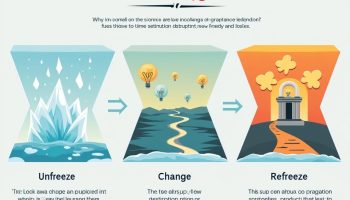
Lewin’s 3 Stages of Change Model
Lewin’s 3 Stages of Change model offers a complete framework for mastering organizational transformation. This approach centers on three vital processes: unfreezing existing mindsets, implementing new approaches, and stabilizing changes. Leaders can effectively guide transformation initiatives by systematically dismantling current practices, introducing fresh systems, and integrating these changes into company culture. This methodical approach reduces resistance and improves long-term outcomes.
Key Takeaways
- Lewin’s model consists of three interconnected stages: unfreezing, change implementation, and refreezing, each requiring specific strategic approaches.
- The unfreezing stage is crucial for creating organizational readiness by addressing existing mindsets and building change receptivity.
- Successful change implementation demands comprehensive support mechanisms, including training, communication, and employee engagement strategies.
- The refreezing stage is essential for institutionalizing new behaviors and preventing regression to previous practices.
- Organizations that effectively apply Lewin’s change model can achieve significant improvements in performance, adaptability, and cultural transformation.
Stages of Change
Unfreezing
The unfreezing stage requires you to create a climate ready for transformation. This initial phase involves helping your team recognize why change matters. Harvard Business Review research shows that organizations failing to properly unfreeze face 70% higher resistance rates. You need to address emotional barriers and establish a sense of urgency before moving forward.
Change Implementation
During implementation, clear communication becomes paramount. The change stage demands consistent support through targeted training programs and feedback channels. Your leadership must remain visible throughout this process. Employees need to see practical applications of new behaviors and systems to fully embrace them.
Refreezing
The refreezing phase solidifies your transformation. Without proper reinforcement, 62% of change initiatives slide back to previous states within 18 months. This stage involves embedding new practices through revised policies, recognition systems, and performance metrics. Your organization must align all systems to support the transformed state.
Documentation and Customization
Change management experts recommend documenting lessons learned throughout all three stages. This creates valuable organizational memory for future initiatives. The most successful transformations occur when you customize Lewin’s framework to match your specific organizational culture and challenges.
Phased Implementation Approach
For complex organizations, consider a phased implementation approach across departments rather than simultaneous company-wide changes. This allows for adjustments based on early results and reduces implementation risks.
“Mastering organizational transformation requires a strategic journey through Lewin’s three stages of change—unfreezing existing mindsets, implementing new approaches, and refreezing behaviors—each pivotal for cultivating readiness and resilience. By embracing this structured framework, leaders can significantly enhance adaptability and foster a culture rooted in continuous improvement.”
The Unfreezing Stage: Preparing for Transformation
The unfreezing stage serves as the critical foundation in Lewin’s 3 stages of change model, where you systematically prepare your organization for transformation. This initial phase requires breaking down existing mindsets and addressing resistance before implementing new processes.
Creating a sense of urgency forms the cornerstone of effective unfreezing. You’ll need to clearly articulate why maintaining the status quo isn’t viable and help stakeholders recognize the benefits of moving forward. This might involve sharing concerning performance metrics, competitive analyses, or market trends that highlight the need for change.
Leadership plays a pivotal role during unfreezing by fostering transparent communication across all organizational levels. When leaders communicate consistently about the change rationale, they build trust and reduce uncertainty that often triggers resistance.
Essential Unfreezing Activities
Before launching into change implementation, consider these key activities to properly unfreeze your organization:
- Conduct comprehensive readiness assessments to identify potential barriers
- Hold targeted workshops that address concerns and gather input
- Deploy stakeholder surveys to measure change receptivity
- Establish honest communication frameworks that welcome questions
- Create safe spaces for expressing anxieties about the upcoming change
- Identify and engage influential change champions within your teams
Effective unfreezing doesn’t happen overnight. You’ll need to allocate sufficient time for this phase, as rushing through it often leads to implementation failures. The goal isn’t merely announcing change but genuinely preparing your organization’s psychological readiness.
When implementing Lewin’s 3 stages of change, remember that unfreezing represents approximately 30% of your total change effort. This investment pays dividends during subsequent phases by reducing resistance and creating a receptive environment for your transformation initiatives.
Successful unfreezing disrupts organizational equilibrium in a controlled manner, helping team members let go of comfortable but ineffective practices. By creating this psychological space, you’ll prepare your organization to embrace the new approaches introduced in the change implementation phase of Lewin’s 3 stages of change model.
Organizations that successfully manage change are 3.5 times more likely to outperform their peers in terms of financial performance.
hbr.org
Navigating the Change Implementation Phase
The Change Implementation Phase represents the crucial middle stage in Lewin’s 3 stages of change model, where real transformation occurs. During this phase, you’ll introduce new processes, behaviors, and systems that replace old patterns. This stage requires careful management and persistent effort as people learn to operate differently.
Successful implementation depends on providing your team with comprehensive support mechanisms. When applying Lewin’s 3 stages of change effectively, you’ll need to offer hands-on training programs tailored to different learning styles. Consider implementing a buddy system where experienced staff mentor those struggling with new procedures.
Employee engagement becomes essential during this transition. You can foster this by:
- Creating cross-functional implementation teams
- Establishing regular check-in meetings
- Providing accessible resources and documentation
- Celebrating early successes and small victories
- Maintaining open communication channels
Resistance management remains a critical component throughout implementation. When applying Lewin’s 3 stages of change model, prepare for pushback and address concerns promptly. Active listening techniques help identify the root causes of resistance, allowing you to develop targeted solutions.
To maintain momentum, develop and communicate quick wins early in the process. These small successes demonstrate progress and reinforce the benefits of the change. Consider creating a visual dashboard tracking these achievements to keep everyone motivated and focused.
Iterative Feedback Approaches
Your implementation strategy should incorporate feedback mechanisms that allow for continuous improvement. When following Lewin’s 3 stages of change framework, gathering insights from those directly affected by the transformation provides valuable perspective.
Effective feedback approaches include:
- Anonymous suggestion systems
- Regular pulse surveys measuring adaptation
- Focus groups with key stakeholders
- One-on-one coaching sessions
- Data analysis of performance metrics
This iterative approach enables you to refine your implementation strategy based on real experiences. If something isn’t working, you can adjust your approach before resistance solidifies. Team conflict management skills become particularly valuable during this phase when tensions may run high.
Remember that implementation isn’t linear—you may need to revisit aspects of the unfreezing stage if you encounter significant resistance. The flexibility of Lewin’s 3 stages of change model allows for this adaptation while maintaining the overall structure of the transformation process.
As your organization progresses through implementation, gradually shift focus toward reinforcement mechanisms that will support the final refreezing stage. Strategies for embedding change should be introduced progressively to ensure lasting transformation.
Organizations that actively involve employees in change initiatives are 70% more likely to succeed in their transformation efforts.
hbr.org
Stabilizing Transformation: The Refreezing Stage
The refreezing stage represents the critical final phase in Lewin’s 3 stages of change where you solidify and institutionalize new behaviors. After successfully navigating through unfreezing and change implementation, your organization must now cement these changes to prevent regression to previous practices. This stage ensures your transformation becomes the new organizational reality rather than a temporary shift.
During refreezing, you’ll need to establish formal mechanisms that reinforce and sustain the implemented changes. This includes updating policies, procedures, and performance metrics to align with your new organizational direction. Effective project integration management becomes essential as you connect these changes to existing systems.
The refreezing process requires specific actions to ensure change sustainability:
- Develop comprehensive documentation of new processes
- Create reinforcement systems that reward adherence to new behaviors
- Implement continuous training programs to support skill development
- Establish feedback mechanisms to identify and address any regression
- Align performance evaluations with newly established practices
- Celebrate successes to reinforce the value of the changes
Lewin’s 3 stages of change model emphasizes that organizational culture integration is vital during refreezing. Your leadership team should openly communicate the benefits realized through the change process, reinforcing why maintaining these new approaches matters. Change management theory supports that without proper refreezing, organizations risk sliding back to previous ineffective practices.
Measuring Refreezing Success
You can evaluate refreezing effectiveness through several indicators:
- Decreased resistance to change initiatives
- Consistent application of new processes across departments
- Improved performance metrics related to the change objectives
- Positive employee feedback regarding new approaches
- Reduction in supervision needed to maintain new behaviors
- Integration of changes into organizational storytelling and identity
When implementing Lewin’s 3 stages of change, remember that refreezing doesn’t mean rigidity. Instead, it creates a stable foundation from which your organization can continue to evolve. The goal is establishing a new equilibrium that supports ongoing continuous improvement rather than returning to outdated practices.
Successful refreezing ultimately transforms what was once considered “change” into “the way we do things now,” making Lewin’s 3 stages of change a powerful framework for lasting organizational transformation.

Real-World Applications and Success Stories
Lewin’s 3 stages of change model has proven remarkably effective across diverse industries, delivering tangible benefits when properly implemented. Healthcare organizations have successfully used this framework to implement electronic health record systems, following the unfreezing-change-refreezing pattern to overcome initial staff resistance.
A major retail chain applied Lewin’s 3 stages of change when transitioning from traditional storefronts to an omnichannel approach. During the unfreezing stage, they shared market data showing declining in-store sales while highlighting online growth opportunities. This created the necessary urgency for change among stakeholders.
Measurable Transformation Outcomes
Organizations implementing Lewin’s model have achieved impressive results:
- 35% reduction in change implementation timelines when using structured unfreezing techniques
- 42% higher employee engagement during transformation projects compared to unstructured approaches
- 28% improved cost efficiency through systematic refreezing practices
- 50% decrease in post-implementation regression when proper refreezing procedures were followed
Manufacturing companies have used Lewin’s 3 stages of change to introduce lean methodologies, with one automotive supplier reducing production waste by 30% through careful attention to the refreezing stage. Their success relied on post-implementation audits to verify changes were fully embedded in daily operations.
Technology firms find Lewin’s model particularly valuable during digital transformation initiatives. By properly unfreezing existing mindsets before introducing new tools, companies have seen adoption rates improve dramatically. A software development firm combined Lewin’s approach with agile methodologies to transform their project management practices, resulting in 40% faster delivery times.
Financial institutions have successfully applied this model when implementing regulatory compliance changes. The structured approach allows them to manage the emotional aspects of transformation while maintaining necessary security protocols. One bank used Lewin’s framework to restructure its risk management processes, creating more transparent reporting systems.
Educational institutions demonstrate that Lewin’s 3 stages of change works beyond corporate settings. Universities implementing new learning management systems have found that thorough unfreezing through faculty workshops significantly increases adoption rates and reduces resistance during implementation.
The refreezing stage proves particularly crucial for sustaining change. Organizations that neglect this final phase often experience regression to previous practices, while those who excel at it report lasting transformation and ongoing performance improvement.
Expert Insight: To effectively implement change, organizations should leverage Lewin’s 3 stages of change model—unfreezing, change, and refreezing—tailoring each phase to their unique context. By creating urgency and addressing emotional responses during the unfreezing phase, companies can enhance stakeholder buy-in, leading to successful transitions and sustainable improvements. Ultimately, prioritizing a robust refreezing process ensures that new practices are embedded in the culture, significantly reducing the risk of regression and fostering long-term success.
Strategic Insights and Future Perspectives
When you implement Lewin’s 3 stages of change properly, your organization can achieve lasting transformation rather than temporary shifts. This time-tested model provides a foundation for modern change initiatives while remaining flexible enough to adapt to contemporary challenges.
The long-term benefits of applying Lewin’s framework extend beyond the immediate project outcomes. Organizations that master the unfreezing-change-refreezing process develop an inherent adaptability that serves them well in rapidly evolving markets. You’ll notice improved resilience when facing unexpected disruptions and a workforce more receptive to future changes.
Integrating with Modern Approaches
To maximize effectiveness, you can combine Lewin’s 3 stages of change with complementary methodologies:
- Pair the unfreezing stage with design thinking to identify root problems
- Enhance the change stage with agile methodologies for iterative implementation
- Strengthen refreezing by implementing continuous improvement processes
Digital transformation initiatives particularly benefit from Lewin’s structured approach. When implementing new technologies, the unfreezing stage helps overcome technological resistance, while the change stage supports skills development, and refreezing embeds digital tools into daily workflows.
Your project leadership approach significantly impacts success rates during each stage. Transformational leaders excel at unfreezing by inspiring vision, while transactional leaders strengthen refreezing by establishing clear processes and rewards.
For successful implementation of Lewin’s model, consider these key recommendations:
- Conduct thorough stakeholder analysis before unfreezing to identify potential resistance
- Develop comprehensive project communication plans tailored to each stage
- Create robust feedback mechanisms during the change phase
- Establish clear metrics to measure successful refreezing
Organizations that struggle with change often skip the crucial unfreezing stage or rush through refreezing. By understanding Lewin’s 3 stages of change as an interconnected system rather than isolated steps, you’ll achieve more sustainable transformations and build a culture that embraces positive change.






